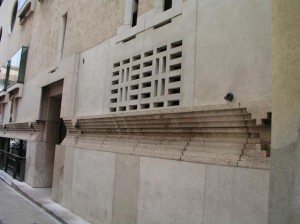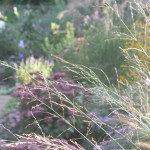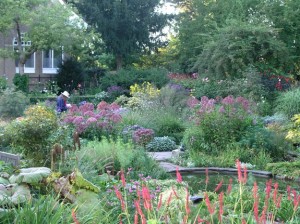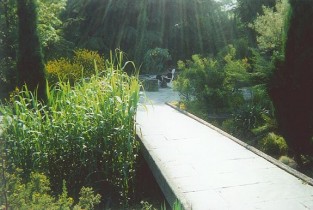Northern European planting design as a prototype for NZ
The following essay was presented by Philip Smith (o2 Landscapes) at the International Plant Propagators’ Society conference in Auckland. Below is the first of the two part essay.
Pluralism in design
Modern culture (and particularly design) seems to be heavily concerned with reinventing almost everything. This has been evident in New Zealand gardens, where we have seen a major shift in recent years, especially from a state of heterogeneity towards a more homogeneous industry. There has been a reduction in the range of plants available, and the manner in which these plants are used. As a result, gardens in general within New Zealand are becoming culturally and botanically less diverse.

Brachyglottis haastii
Rather than enter into further erudite discussion regarding the reasons behind this direction within horticulture, I will just state my position on it right now. I don’t like it. In pursuing the simplicity, unity and cohesion that modernism values highly, landscape designers are increasingly producing bland, over-simplified ‘products’. Dynamism is under-valued. Detail is surrendered in deference to ‘clean lines’ and surface. Beauty is expressed in relation to a limited range of abstract concepts, rather than felt on a basic, visceral level.
Similar misgivings have led to re-examination of the domination of modernist thought in other disciplines, most commonly expressed in Post-Modern theory. In his book, ‘Intercultural Architecture’, the Japanese architect, Kisho Kurokawa, describes Post-Modern design as being multivalent; that is, it is derived from a variety of influences which reflect the complexity of our human and natural environments. He also presents the interesting proposition that a high level of dynamism can be achieved out of ambiguity, in which seemingly opposing characters can be expressed within the same thing (whether that thing is a person, building, garden or otherwise). In the case of gardens, an example may be gardens which express the character of the native landscape, combined sensitively with the best aspects of our introduced horticultural traditions. The tension between nature and artifice can create a dynamic middle ground which is actually more relevant to the modified landscape within which we live.

Banca Popolare di Verona (by Carlo Scarpa)
In my design work, I am particularly influenced by the legacy of the Venetian architect, Carlo Scarpa. Scarpa was outstanding amongst modern architects in expressing pluralism within his work, particularly in his integration of modern design principles and tradition. At the same time as pursuing progressive design, he interpreted and translated local traditional forms and finishes within his work. Through integrating seemingly disparate influences, Scarpa created buildings and landscapes which link the local heritage with more recent aspects of the landscape, thereby bringing tradition forward and making it relevant to contemporary society. Integration, namely of traditional gardening and progressive design, is also the hallmark of naturalistic Northern European planting design.
Evolution of planting design in Northern Europe
At the turn of the 20th Century, gardens and man-made landscapes were mainly divided into the categories of functional landscapes, formal gardens and flower gardens. Generally speaking, nature wasn’t an important guiding influence. Within this context, Karl Foerster started his work as a plant breeder and nurseryman. Foerster was the foremost pioneer of naturalistic planting design within northern Europe. Attached to his nursery (and surrounding his house), Foerster planted experimental gardens in which he developed improved varieties of perennials (most importantly with Delphinium and Phlox), and worked on theories regarding planting design.

Foerster grass
Foerster’s greatest contribution to modern planting design was his advocacy of the use of grasses and ferns alongside perennials, to emulate the effect of natural planting associations. His work has been further developed since his death by his daughter, the landscape architect, Marianne Foerster, who undertook experimental work in the gardens attached to the Foerster family home until her passing in early 2010. All photos of Foerster’s garden that are shown in this essay actually represent the original work of Karl Foerster in combination with the continuation of that legacy by Marianne.
A major advantage of the use of grasses within perennial gardens is an increased sense of depth, due to the fineness of texture they deliver and their comparatively amorphous form. Pseudo-ecological planting associations also provide a connection with outer landscapes (those beyond our built environments). Foerster did not just promote the outcome of his work through the outlet of the nursery. He wrote several books, including ‘Einzug der Gräser und Farne in die Gärten’ (‘Introduction of Grasses and Ferns into Gardens’).

Foerstergarten
German and Dutch designers and plantspeople who followed Foerster continued to develop experimentation in naturalistic planting design. The Dutch landscape architect, Mien Ruys, was exceptional in her ability to integrate the soft, naturalistic planting style advocated by Karl Foerster with more structured planting, and progressive design of ‘hard’ elements within her gardens (that is; paving, walls, furniture).
A figure that many will be familiar with is the Dutch designer, Piet Oudolf. Oudolf is one of the foremost figures within contemporary European landscape design. A particularly impressive aspect of his success is that he is a designer who has developed his style on the experience of having bred plants within his own nursery at Hummelo. He assembled plants from far afield to gather the base for his propagation and breeding work, including material from the German plantsman, Ernst Pagels, who was a student of Karl Foerster. Pagels was an influential plantsman based in the region of Germany within which I was fortunate to work for a period, close to the border with the Netherlands.
Oudolf’s public plantings are often composed of massed drifts of perennials and grasses, which blend into each other. However, within his own garden and in various private commissions, he arranges plantings in a more intimate fashion, with diverse ranges of plants put together in the manner of natural landscapes. Oudolf describes plant characteristics based on the overall effect of plants, rather than on conventional manners of describing plants, which tend to be far more direct. Plants are valued for such characteristics as their diaphanous nature, or the way in which they project from a planting, in addition to the usual perception of plants in terms of flower colour or foliage form. For such an approach, it is valuable to understand how plants grow within their natural habitats, and the aesthetic orders that develop through ecological relationships.
Critical assessment of the ecologies and growth forms of plants within their natural habitats (or situations that emulate their natural environments) has been the subject of extensive research within German landscape design. Professor Richard Hansen and Friedrich Stahl made the ecological analysis of perennials the subject of their book, ‘Die Stauden und ihre Lebensbereiche’ (‘Perennials and their Habitats’), based on experimentation at the University of Weihenstephan. The landscape architect, Rosemary Weisse, carried out interesting research in Munich’s Westpark, based on a regime of neglect, in order to better understand the natural tolerances of plants and develop more sustainable paradigms for ornamental plantings. Public gardens such as this have played an important role in the development of naturalistic gardens in Germany. Two other major public gardens where progressive work has been undertaken for a long period are Hermanshof garden at Weinheim, and Hamburg’s ‘Planten un Blomen’.

Planten un Blomen
It is interesting to note that the name of the latter is simply a dialectual translation of ‘Plants and Flower’; an expression of intent that the park is primarily about plants and flowers, in combination with providing usable spaces for the people of Hamburg. Upon visits to ‘Planten un Blomen’, I was struck by just how well used this park is. Aside from the innovative plantings, spaces are organised very well within the park. Various areas of different size and aspect allow for differing uses, such as a terrace which contained a large number of in-situ chess tables, lawn expanses, or more intimate spaces in which movable garden furniture is placed (so that people can define their own use of the space and feel like they are in a garden of their own).
Through experimentation in the design of gardens within public and private spaces, and extensive plant breeding, German and Dutch designers have progressed the naturalistic style to be one of the most exciting informal design movements in the world, and one which is flexible in how it may be applied. Due to the sensitive nature of this garden style, it has interested me as inspiration for garden-making within New Zealand, where the basic elements of our natural landscapes and traditional gardening aesthetics are relatively sensitive in character.
Next installment – Adaptation of the Northern European naturalistic model to NZ.

